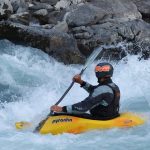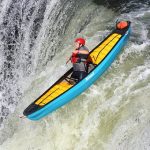I often receive a reaction of apprehension when introducing people to kayaking, usually stemming from the misconception that kayaks capsize easily and one could get stuck underwater.
Nowadays, this is luckily just a misconception.
Flipping in a kayak can be a frightening experience for some, however, it is very difficult to accomplish and there are numerous steps you can take to reduce the fear associated with it.
What causes kayaks to flip?
There are many reasons why kayakers may flip over. Some kayakers purposefully capsize their boat on purpose as part of their recreation, while others may overturn unintentionally.
Reasons for turning over a boat can include striking a wave or something blocking the vessel’s progress, as well as sinking caused by an unequal load distribution. Let’s analyze these!
Losing your balance
The most usual cause of capsizing a kayak is when the weight isn’t balanced and the vessel begins to lean over. This can be caused by improper loading of the kayak, an improper sitting position of the person paddling, or the paddler leaning too far to one side.
Newcomers to kayaking may find difficulty in maintaining their balance and keeping the kayak steady. Although the odds of toppling over are slim, they could still be in danger of overturning, particularly if they are not at ease and in control.
Gaining experience with the instability of a kayak and learning how to adjust yourself when a wave appears requires practice.
For good fortune, the majority of recreational kayaks made for novices nowadays have remarkable poise.
As your familiarity with the sport increases, you will become more adept at manoeuvring yourself around in the kayak and quickly overcoming any possible overturns.
Eventually, kayaking will become second nature, and you won’t have to worry about flipping the kayak over!
Hitting an obstacle
If the kayaker isn’t paying attention and they inadvertently encounter a wave or stone, it can cause them to wreck. It is essential to be conscious of your surroundings when kayaking, not just to avoid capsizing.
There are dangers present in large bodies of water that can lead to capsizing. When in choppy or rocky seas, be very conscious of the state of the water and be watchful for any objects in it (if visible).
For kayakers who are not used to paddling, it can be beneficial to practice in a tranquil lake or river that you are already familiar with.
This can help you become more accustomed to the motions of kayaking and set you up for more intense conditions.
What can you do to prevent your kayak from flipping?
If you haven’t tried kayaking before, you might be worried about the prospect of capsizing. Don’t be concerned, though, with a bit of practice and the correct methods, you should be able to sidestep flipping your kayak all together.
Here are a few things you can do to prevent this:
Practice proper paddling techniques
A few essential advantages exist for utilizing accurate paddling techniques in order to keep your kayak from capsizing.
Using good paddling technique will allow you to have more strength while keeping your kayak on its designated course. This can stop you from inadvertently turning into waves or stones which could make your kayak capsize.
It is essential to ensure that your strokes are both consistent and forceful. Don’t employ excessive effort on one side, as this could prompt your kayak to swerve off track and possibly overturn.
Furthermore, proper technique can ensure that you stay balanced and do not lean too far to one side, which could lead to your kayak toppling over.
Learning how to use a low or high brace can aid in preventing a possible capsizing.
If you are adept in paddling your kayak, you can swiftly and accurately respond when it begins to overturn, thereby helping to prevent a total capsize and maybe even straighten your kayak before it turns over.
Stay aware of your surroundings
Pay attention to the strength of the wind and the existing weather patterns, as they can affect the steadiness of your kayak. If you’re feeling unsure, keep a close eye on the forecast and go outside with a companion.
Be vigilant for signs of powerful currents, oversized waves, and gusty winds. If possible, steer clear of these things, or be ready to use greater safety measures.
For instance, if the water is flowing rapidly, you may need to paddle vigorously to maintain your kayak staying on a direct course. Ensure that your kayak is facing the direction of the big waves, so they don’t crash into your kayak and cause a capsizing.
Pay attention to which direction the wind is coming from when dealing with strong gusts, and steer yourself accordingly.
Use your gut feeling as well. If you feel particularly unsteady in an area of water. It may be your gut feeling detecting an increased amount of instability that you may not be completely conscious of yet.
Your body will instinctively sense slight alterations like this ahead of you being entirely aware.
Being aware of what is around you and taking extra care when necessary can reduce the risk of your kayak capsizing.
Sit-in/Sit-on-Top Kayak: Which May Flip Easier?
The steadiness of a kayak is mainly determined by the design of its hull. Kayaks currently on the market are highly balanced and come in a variety of shapes and sizes.
It is difficult to determine which type of kayak, a sit-in or a sit-on-top, is more likely to capsize due to the diversity of designs for each. The chance of flipping over in a kayak is partially determined by the material that it is made of.
But one thing is for sure. It is simpler to get out of a sit-on-top kayak if it has been overturned. You may experience a sense of being confined when sitting in a kayak. You may not be able to immediately evacuate from your seat when the boat overturns.
Making the effort to rise out of the chair might be necessary.
Pick the Right Kayak
If you want to take a trip in a kayak on calm water, then a recreational kayak is the perfect choice. Choose a model that offers good primary stability. If you are considering exploring coastal areas, choose a sea kayak that has excellent stability when tipped.
If the kayak capsizes, how one should handle the episode largely depends on the model of kayak it is.
A sit-on-top kayak is much safer than a sit-in kayak, particularly for a person just starting out.
Choose Paddling Conditions That Suit Your Ability
Plan your trips when the weather is fine. Unfavorable weather can make your kayaking adventure unpleasant, and even put you in danger.
Never pick an ultra-light kayak for whitewater paddling. There is a possibility that your kayak could be overturned due to rough waters.
Keep Balance of Your Kayak
While in the kayak, your torso should be in a vertical, erect position. Maintain a loose lower back as you row, and engage your core muscles. Do not jerk.
Use commonsense when stuffing the boat. Distribute objects evenly along the length and width. If you’re prone to losing your balance, hit the surface of the water with your paddle.
This will aid you in keeping equilibrium for a short period of time and get going once more.
Practice Your Paddle Skill If Your Kayak Tilts
A good move when kayaking is to employ a brace to remain balanced and keep your kayak from capsizing. You cannot be considered an experienced paddler until you have mastered the art of low and high bracing.
First, let’s see how to perform the low brace. Begin by keeping the paddle shaft close to your chest near the front. Move your wrists upward so the back of the paddle blade is level with the water. Push your elbows forward while keeping your wrists below.
When you are in a kayak, move it towards the side you are supporting. Raise your arm and make contact with the water using the edge of your hand. Put your head against the supporting side and lift your leg at the same time until your kayak is back in an upright posture.
Using a high brace is one way to avoid flipping your kayak over. To begin, grasp the paddle stick higher than you would when making the low support.
Keep the blade of the paddle facing the water parallel, rotate your wrists backwards, and point your elbows downwards. Maintain the same level of your elbows while placing the kayak onto the stabilize portion.
Hit the water with the blade and turn your face to the side that feels the wind. Maintain your torso in the same posture and your head angled up as you bring your knee up until your kayak has been righted.
Practice Flipping and Re-Entering Your Kayak
Prepare yourself for the event of a capsize. Instead of waiting for an upsetting situation, try flipping your kayak on purpose and find out how difficult or straightforward it is to get back in.
By doing this, your talents will be honed, you will have more faith in yourself, and you will be more ready to handle matters if your kayak flips over.
Could It Be Fatal If I Capsize a Kayak?
Yes, it could be. Flipping a kayak can be perilous, similar to experiencing mishaps when walking through a roadway, biking, or commuting to work. Take steps to reduce the possibility of capsizing and be ready for the worst situation.
When kayaking, it is important to put on a buoyancy aid or life jacket. If you don’t think you are ready to take on the responsibility of controlling a kayak, you should probably avoid it entirely.
There are numerous fascinating activities to pass the time, and you’ll come across one that fits your personality.
What To Do If Your Kayak Capsizes?
If your boat were to flip over, keeping your composure is the most essential thing. Once you realize that your kayak has flipped over, concentrate on making sure you are safe.
Turn the overturned kayak right side up and return to the seat. Lighten the kayak by getting water out of it. The way in which you handle the problem varies depending on the kind of kayak and how many individuals are using it.
Focus on saving yourself if you are alone. If you are in a group, take the necessary steps to ensure the safety of everyone involved.
Self-Rescue
If you are well-prepared, an unexpected overturning of a vessel isn’t as frightening. It is usually relatively simple to re-enter a sit-on-top kayak. This is due to the lack of a spray skirt, and the design of the vessel allows for simpler positioning of your legs.
A sit-on-top kayak does away with the need to bail out water, so getting back into the boat is not so hard.
If your kayak is turned over, turn it back to an upright position first. Stand next to the boat, before your seat. Grip the side of the vessel securely while your lower half stays buoyant in the liquid. Climb aboard the ship and return to your spot.
Getting back into a sit-in kayak after an incident can be challenging. If you discover that your kayak has overturned and you are still occupying the seat, deliberately try to exit the seat.
Get Help
Gaining proficiency with T-rescue can be immensely rewarding for an avid paddler. It means to enlist the assistance of a friend when your kayak flips over. T-rescue can only be effective when someone is present to help. Here’s what the procedure looks like:
With a rescuer nearby, your kayak flips. You signal your need for assistance by slapping the sides of the vessel three times with both hands. The rescuer kayak approaches your kayak at 90°. You hold onto the front of the boat and use it to help you stand up.




